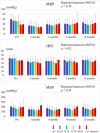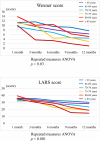Defecation disorder and anal function after surgery for lower rectal cancer in elderly patients
- PMID: 35106420
- PMCID: PMC8786691
- DOI: 10.1002/ags3.12505
Defecation disorder and anal function after surgery for lower rectal cancer in elderly patients
Abstract
Aim: This study aims to investigate the association of patient age with defecation disorders and anal function after lower rectal cancer surgery.
Methods: We retrospectively reviewed the data of 141 consecutive patients with lower rectal cancer who underwent sphincter-preserving operation. The patients were classified into five categories by age thresholds at 65, 70, 75, 80, and 85 years, for disaggregate analysis. Anal manometry was used for measuring the maximum resting pressure, high-pressure zone, and maximum squeeze pressure. Anal manometry was performed preoperatively and at 3, 6, 9, and 12 months postoperatively. The Wexner and low anterior resection syndrome scores were assessed at 1, 3, 6, 9, and 12 months after rectal surgery or stoma closure for patients with ileostomy.
Results: The data of 117 patients were reviewed. No significant differences were found between the younger and elderly groups in any characteristics across the six age groups. The preoperative intra-anal pressures of the elderly patients were slightly lower than those of the younger patients; however, there was no significant difference in the course of postoperative intra-anal pressures. Defecation disorder, as measured by the Wexner and low anterior resection syndrome scores, improved significantly in elderly patients compared to younger patients.
Conclusion: There was no significant difference in the course of postoperative intra-anal pressures between the elderly and younger patients. However, defecation disorders in elderly patients significantly improved compared with younger patients. Sphincter-preserving operation can be a viable treatment option for active elderly patients.
Keywords: elderly; intra‐anal pressures; low anterior resection syndrome; rectal cancer; sphincter‐preserving operation.
© 2021 The Authors. Annals of Gastroenterological Surgery published by John Wiley & Sons Australia, Ltd on behalf of The Japanese Society of Gastroenterological Surgery.
Conflict of interest statement
Conflict of interest: Authors declare no conflict of interest for this article. Ethical statements: The protocol for this research project has been approved by a suitably constituted Ethics Committee of Sapporo Medical University and it conforms to the provisions of the Declaration of Helsinki (Committee of Sapporo Medical University, Approval No. 312‐130). The requirement for informed consent was waived due to the retrospective nature of this study.
Figures




References
-
- Center for cancer control and information services [internet] . National Cancer Center; 2019. Available from: http://ganjoho.jp/reg_stat/statistics/stat/summary.html
-
- Shirouzu K, Ogata Y, Araki Y, Sato Y. A new ultimate anus‐preserving operation for extremely low rectal cancer and for anal canal cancer. Tech Coloproctol. 2003;7(3):203–6. - PubMed
-
- Molnar C, Nicolescu C, Grigorescu BL, et al. Comparative oncological outcomes and survival following surgery for low rectal cancer – a single center experience. Rom J Morphol Embryol. 2019;60(3):847–52. - PubMed
LinkOut - more resources
Full Text Sources

